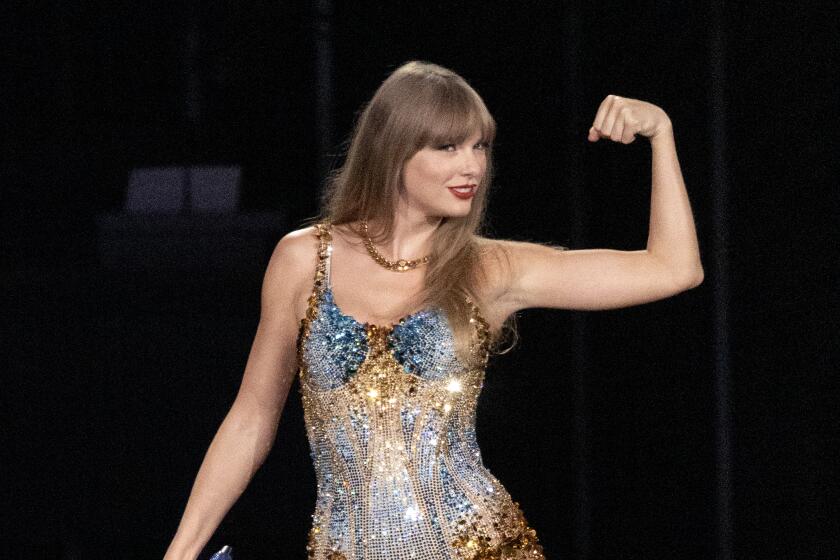LAUGHTER AND TEARS AT ANTONE’S BLUES FESTIVAL
- Share via
AUSTIN, Tex. — The blues is a feeling, happy and sad. It’s love, love gone good, love gone bad. Mainly it’s music. It’s where every bit of modern music has been stolen from. --Clifford Antone
No one could bring more of a curator’s zeal to an art form than Clifford Antone, whose nightclub, Antone’s, celebrated its 10th anniversary over the weekend.
But Antone is no sleek academic skilled at addressing boards and coddling wealthy patrons. A dark-haired, anxious, somewhat overweight and disheveled man in his mid-30s, he’s zealously dedicated himself to one field, the blues. Last weekend culminated a nearly monthlong festival of classic old and not-so-old blues performers who have played Antone’s over the last decade.
The roster included Eddie Taylor, Jimmy Vaughn, Sunnyland Slim, Pinetop Perkins, Snookie Pryor, Angela Strehli, James Cotton, Jimmie Rogers, Albert Collins, George Raines, Mark Kazanoff, Lu Ann Barton, Sarah Brown and Derek O’Brien. Most, if not all, have reputations that go beyond Antone’s (Slim has been performing since the ‘30s and Strehli played Carnegie Hall in October), but it’s always home for them when they’re in Austin.
Nor is Antone’s a shrine for gentrified reverence. Five clubs preceded it at its Guadalupe Avenue address; the building and its gravel parking lot suggest what once could have been a body-and-fender shop. It’s two bucks to get in. You can buy Antone’s T-shirts, posters and commemorative books at the door; turn left to partake of Stubb’s Bar-B-cue, the mystery ingredient of whose sauce has been transferred intact from Lubbock. Straight ahead are the bar, tables and dance floor--the club’s capacity is 400. If you order a beer, it comes without a glass.
Angela Strehli and her four-piece band opened the weekend on Friday night. (Each night consisted of three long sets by musicians who were featured on their own but often sat in one another’s session.)
The group started with “The Thrill Is Gone.” Strehli came on to sing “Little Too Late,” “C.O.D.” and “Breaking Up.” A tall woman with smooth skin, high cheek bones and a strong jawline, she wore a ‘40s-style dress splashed with tropical colors. Her voice was strong, supple and clear, her style understated. When Mel Brown stepped out to play some piercing licks on his electric guitar, she turned to him with an acknowledging hand, as if indicating, “What else is there to say?”
“I graduated from the University of Texas,” she said later. “I was a psychology and sociology major. But I’m crazy about ethnic music.
Pop doesn’t move me. Texas-style blues differs from other styles, like the Chicago style, for example, which is subtler. With Texas blues, the guitar is prevalent, and the beat is stronger. But the blues is the blues. It’s tellin’ the truth and laughing about it.”
One of the paradoxes of the program was that singers could sing of the deepest sadness and bone-deep weariness, and people would dance as well as listen. Perhaps that had to do with the brightness of the playing and, as Strehli said, the strength of the beat.
Albert Collins, a wiry, intense guitarist backed by seven pieces, delivered a set that included “Angel of Mercy,” “I’m a Tired Man” and a febrile “Got That Feeling.” Snookie Pryor on harmonica played “Pitch a Boogie Woogie” and “How You Gonna Shake It Like That?” (subtitled, “Your Daddy Was a Preacher, Your Mama Was an Alley Cat”) in which he and Eddie Taylor on guitar played an extended duologue like an animated conversation.
Pianist Sunnyland Slim, a tall elegant old gent with pipestem arms and legs, performed “Every Time I Get to Drinking” and “She’s Got a Thing Going On.” His voice was the most reminiscent of the older line of country blues: dusky, resonant and hollow, the voice of someone who’s come inside from a long trek. At one point he yelled, “Hey, ladies, let me hear ya!” and broke into a Woody Woodpecker laugh.
Guitarist Eddie Taylor played “I Cried So Hard For You” and “Sitting Here Thinking.” Jimmie Rogers, who several times during the night announced, “People if they can’t dig the blues they must have a hole in they soul,” followed with a couple of opening and closing shuffles, “Goldtailed Bird” and “You’re Sweet.” Pinetop Perkins closed out the night with two well-traveled classics, “Gee, Baby, Ain’t I Been Good to You?” and “Stormy Monday,” and a languorous “Ida Bea,” whose lyric “I love that woman, but we can’t see eye to eye” summarized one of the blues’ most prominent themes: Men and women at odds with each other also need each other.
The Texas blues style prominently recalls the jump and shout, and at Antone’s the instrumental pieces played out to expansive lengths, sometimes with great intensity. Albert Collins’ “Got That Feeling” evoked the mounting tension of Ravel’s “Bolero.”
There was still a crowd milling around the dance floor after the lights went off on the stand. After the club closed, a number of the musicians stood talking to each other outside by their cars, as if wherever they were going wasn’t quite as good as where they’d just been, playing the blues.
More to Read
The biggest entertainment stories
Get our big stories about Hollywood, film, television, music, arts, culture and more right in your inbox as soon as they publish.
You may occasionally receive promotional content from the Los Angeles Times.






